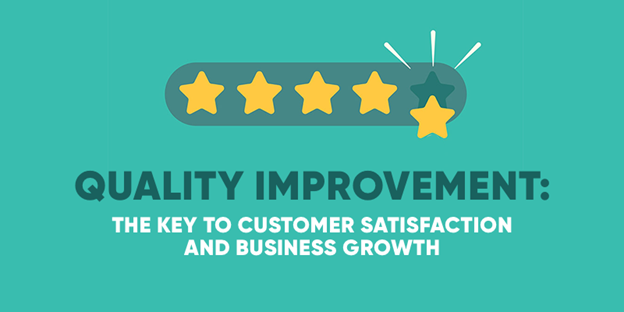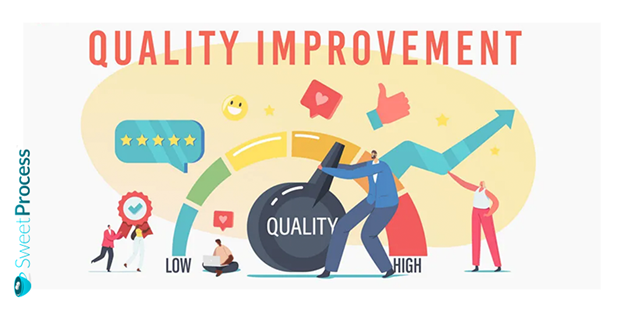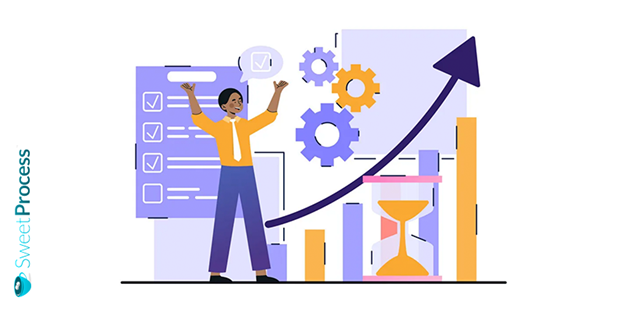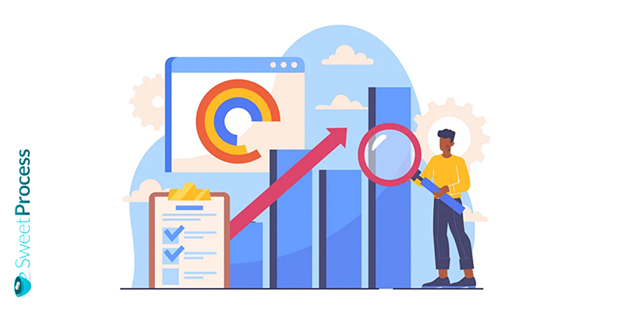Methods to Achieve the Goals of Continuous Quality Improvement Pdsa Smart Hedis
Quality Improvement: The Key to Customer Satisfaction and Business Growth

Organizations have to design their business structure, products, and services depending on customers' needs in order to succeed. However, these needs keep changing over the years, forcing businesses to adopt improvement techniques to achieve customer satisfaction.
Previously, customers were primarily focused on the prices of the products they purchased, but the priorities have now shifted to quality products. In addition to quality products, modern customers also demand fast, responsive, and knowledgeable customer service.
Businesses that fail to assess and improve the quality of their products lose dissatisfied customers, thereby getting low customer lifetime value. The business also incurs higher costs because it has to constantly spend more resources to attract new customers to replace those who left because of the poor quality of products and services. At best, such a business has stagnated growth, and at worst, it collapses due to the loss of customers to competitors that offer customers satisfactory products.
To avoid such a disastrous ending, smart businesses incorporate quality improvement processes in all their functional areas. Quality improvement processes ensure that the company improves its efficiencies and meets customers' growing needs.
When the clients are happy and satisfied, they will stay loyal to your products and services and refer you to potential customers, which is essential for business growth. Customer retention means you'll make more sales, and the organization will become profitable in the long run without investing heavily in marketing or customer acquisition. Done consistently, quality improvement also saves resources that your business would have used to address customer complaints, replace faulty products, or refund the customers.
If you are looking to implement or enhance your quality improvement process, this article will provide information about the different models available, tools of quality improvement, and their importance to your business.
Chapter 1: Quality Assurance vs. Quality Improvement
Chapter 2: Importance of Quality Improvement
Chapter 3: The Evolution of the Concepts of Quality and Quality Improvement
Chapter 4: Quality Improvement Models
Chapter 5: Principles of Quality Management and Quality Improvement
Chapter 6: Common Challenges Experienced During Quality Improvement Processes
Chapter 7: Using SweetProcess in Your Quality Improvement Process
Chapter 1: Quality Assurance vs. Quality Improvement

Quality assurance (QA) is a process that an organization puts in place to ensure the production quality aligns with the customer's needs. This system is based on the production processes and works to improve the quality. It's an integral part of quality management systems used to prevent errors.
Companies incorporate quality assurance in their business functions to help design how a product or service will be delivered. This is done to eliminate the chances that a product will be substandard before it goes to the market. QA's main focus is during the product development phase, making it easier to build in quality. This reduces the time spent on inspecting finished products because the production is flawless.
On the other hand, quality improvement (QI) is a systematic framework that analyzes performance and improves processes and systems. This process aims to consistently look for ways to continually make your outcomes, products, and services better.
Companies use this to determine the functional and operational areas that need improvements. By collecting and analyzing data, companies can develop an improvement plan that even stakeholders can use to monitor and evaluate company results.
QA and QI are similar because they both focus on improving the production process to ensure that the final product is of high quality. The two systems also aim to achieve customer satisfaction.
While QA identifies errors, defects, and mistakes in the manufactured products, QI is more focused on increasing the quality standards to improve the company's productivity. QA is reactive, whereas QI is a proactive approach. In addition, in an organization, QA is carried out by an individual, mostly the engineer, while QI is a responsibility of all employees in an organization.
Difference between quality assurance and quality improvement:
However, although both processes are important in an organization, QI is more advantageous for both customers and businesses because it's a continuous activity. Therefore, the errors are used as an opportunity to learn and improve the quality of products. It also involves the entire team at the company who work together to solve a problem.
Chapter 2: Importance of Quality Improvement

You are likely to experience problems in your company processes regardless of your industry. On most occasions, these issues arise due to different people and processes. QI is used to address these types of problems. Here is why your organization needs quality improvement processes.
Customer satisfaction
According to a PwC report, 59% of U.S. consumers would ditch a product after several poor experiences. Customers are more likely to buy your product and services if their needs are met. If you keep supplying poor-quality products, you'll lose a huge percentage of customers to your competitors.
This is why quality improvement is important in any organization. Everyone on the team can work together to improve the weak areas and contribute to building a quality product. In addition, since it's a continuous process, the issues are identified much faster and addressed immediately to avoid conflicts with the customers.
The best way to achieve this is to understand what the customers expect from you as an organization. One aspect of QI is collecting relevant data that gives you more insight into the consumers. Collect customer feedback regularly and use that to improve the quality of your products.
Keep in mind that if your customers are happy, they become loyal and bring new customers with them. Ignoring this process could cost you customers, which affects the company's revenue.
Higher revenues for the business
When a business is constantly improving, the customers stay happy, increasing sales and cash flow. Implementing a quality improvement process is vital in boosting overall company revenues. As more customers purchase your products and services, the better your profit.
Therefore, if your business is experiencing constant losses, you should use QI to analyze which processes need improvement. Use the data from customer surveys to identify the weak areas and use that information to make the business better.
Investing in this framework will protect the organization from losing customers and incurring losses. Ensure that the process is continuous to make it easier to identify problems early enough before they significantly affect your income.
Reduction of errors and wastage of business resources
If your organization does not have a QI system in place, you are highly likely to have many errors and waste business resources. Continuous QI reduces the number of errors such as defective products and mistakes when delivering services to the customers. These errors can be quite costly to the organization in terms of money and time.
Furthermore, quality improvement is implemented at every management level; therefore, every staff member must abide by the set processes. If there are more human errors, the product quality will reduce, affecting productivity and overall output. Research shows that human error is responsible for up to 90% of workplace accidents that cost money and interrupt productivity.
Sectors such as healthcare are quite sensitive; therefore, it's important to ensure that there are no errors. Health facilities incur high costs if the systems are unreliable or have flaws. QI helps improve patient health outcomes, boosting service delivery and decreasing mortality rates.
If your company is a small startup, the impact of the errors will be more costly than in larger companies. To avoid this, it's important to constantly identify potential sources of errors and fix them as soon as possible.
A company with an efficient QI process will also have less waste because the weak areas are identified and addressed immediately. The organization does not have to allocate any resources to products and services that consumers do not need.
Higher productivity
If the organization earns high revenue, the employees also benefit by getting consistent salaries and benefits. Employees are motivated to perform better if they are paid on time. QI plays a vital role in this because an organization that revises its production process will have fewer slowdowns in the future.
In addition, when an organization introduces a QI process at every management level, employees feel like they are involved in the company's activities. Therefore, they easily get on board with new processes and implement them within a short time.
On the other hand, the entire company can prioritize areas that need improvement. This will ensure a continual flow of products and services which builds the company's credibility.
For instance, the education sector is keen on implementing quality improvement processes. The system analyzes the education and training system and points out areas that need improvement in schools. Teachers and other employees become more productive because they have focus areas that require change.
Continuous quality improvement is used to improve education, both in higher and public education. These improvement methods for education are now beginning to blossom.
Improved morale
Apart from improving the company's output and productivity, quality improvement is also essential for the employees. Company staff prefer working with organizations that have clear goals and objectives to be achieved. When everyone knows what's expected of them, it becomes easier to execute the job.
Workers with high morale are more productive and are less likely to quit their jobs. When the turnover is low, the company does not have to spend a lot of money hiring new employees and training them on the existing quality improvement process. Therefore, the existing employees can maintain the quality standards of your products and services to meet customer needs.
Stand out from the competition
Quality improvement is an important process if you want to outsmart your competitors. Small companies need to put in a lot of effort to compete against the larger corporations. One way to do this is by improving the quality of products and services. When you provide quality products to the consumer, they will stick to your organization and not your competitor.
You will also have an advantage over your competitors because you are cost-efficient and have better resource usage. In the long term, QI builds the company's brand and propels it beyond the competition. With an advanced market position, your organization can enhance its business processes.
Chapter 3: The Evolution of the Concepts of Quality and Quality Improvement

Quality is the degree of excellence. This concept is defined differently in every industry, depending on the end-users. Historically, the healthcare industry in the United States evolved from quality assurance, which emphasized inspection and punishment for medical errors, to quality improvement.
This evolution was sparked by the publication of two studies by the Institute of Medicine: "To Err Is Human: Building a Safer Health System" (1999), which focused on patient safety, and "Crossing the Quality Chasm," which called for a fundamental change in the healthcare delivery system by completely redesigning patient/provider relationships and revising patient care processes, to improved health care outcomes.
In the "Crossing the Quality Chasm" report, quality is based on six dimensions: safe, timely, effective, efficient, equitable, and patient-centered healthcare services. These six dimensions show the complex nature of quality and how it can be measured, defined, and improved upon.
QI dates back to the 1920s and was first applied to the manufacturing industry by pioneers like W. Edwards Deming, Walter Shewhart, and Joseph Juran. These three are widely regarded as the pioneers of QI.
Walter Shewhart—sometimes referred to as the father of statistical control—was a professional engineer who introduced statistical sampling techniques in quality control methods. Most modern quality improvement approaches can be traced back to him and the other two pioneers. W. Edwards Deming heavily influenced the foundational methodologies such as the Toyota Production System, which changed to lean management.
W. Edwards Deming, an eminent scholar and teacher, is considered the leading management thinker in the field of quality. His philosophy focused on continual improvement for both individuals and organizations. As a scholar, he was interested in expanding Shewhart's techniques beyond manufacturing to manufacturing and administrative activities. Notably, in the 20th century, Deming talked about the science of improvement in his System of Profound Knowledge.
He used statistical control tools to determine the sources of variation that contributed to waste in manufacturing. His approach changed the focus from individuals to the underlying process. This paved the way for the how QI is viewed today.
Joseph Juran is also known as the founder of a range of quality management techniques. Juran's quality management approach is based on three key principles: the Pareto principle, also known as the 80/20 rule; quality management principles; and the Juran Trilogy. The trilogy includes quality planning, quality control, and quality improvement.
Quality improvement became quite useful in the healthcare sector. In the 1960s, the Donabedian model developed by Avedis Donabedian, a pioneer in quality studies in healthcare, became globally influential. Healthcare organizations started to use frameworks used in other fields. They began adopting continuous quality improvement (CQI), total quality improvement (TQM), and clinical process improvement (CPI).
These quality improvement techniques developed by the pioneers have been transformed into different models in these modern times. They laid a solid foundation for most QI processes used today in different industries. While the quality processes were developed for the manufacturing industry, they are now useful in sectors such as healthcare and education.
Chapter 4: Quality Improvement Models

I
f you are looking to improve the quality of your products and services, you need to know the different models that you can use. Let's look at the most common ones.
Lean model
The lean model, sometimes referred to as the Toyota Production System, has its origin in Japan's vehicle industry. It was developed just after World War II for car manufacturing. The main objective of this model is to minimize wastage and improve efficiency in procedures and processes. This system proposed that organizations tackle waste in different areas, including inventory, motion, waiting, transport, defects, overproduction, and overprocessing.
This approach to quality improvement is rooted in establishing standardized processes and using data collection to identify opportunities for improvement. The lean model seeks to empower all staff to continuously look for ways to improve the workflow. The model has five core principles: define the value, make the process flow, map the value stream, pull from the customer, and work toward perfection.
For instance, in the healthcare sector, this approach defines value based on the patient's wants and ensures that the process is time-efficient and cost-effective. It focuses on the patient's central position and works to reduce or eliminate all the activities that don't add value to the patient. When healthcare facilities implement the lean methodology, they can minimize inventory, reduce wait times and errors, and prevent injuries.
The lean model can also be applied to other business sectors to decrease operating costs, improve productivity, increase product quality, and achieve greater satisfaction. Lean is best implemented as a long-term process, making it easier for employees to recognize waste through practice.
Model for improvement (PDSA model)
The model for improvement (MFI) was first developed by W. Edwards Deming and the Associates in Process Improvement. As the most commonly used QI approach in healthcare, it was published in The Improvement Guide (first edition) in 1996. The model was then adopted by the Institute for Healthcare Improvement (IHI).
QI model basics:
This model consists of two parts. The first part seeks to address these issues:
- The goals of the project to be accomplished.
- How the team will measure the change as an improvement.
- Selecting changes that will result in an improvement.
The second phase is an action cycle referred to as the Plan-Do-Study-Act (PDSA) cycle that tests the effect of the changes. Therefore, this model is also known as the PDSA method. These cycles can happen rapidly, and several cycles can be completed within one project. Quality improvement teams in an organization test changes designed to achieve the improvement goals by using successive PDSA cycles until they get the desired result that can be implemented.
The MFI and PDSA cycles are quite simple processes but effective. However, you need to know the right way to introduce the MFI model into your company processes for the best results. Once you've mastered how to implement the model, your improvement work becomes effective, and you'll attain the desired outcomes.
In healthcare, PDSA provides important steps for quality improvement. It comes in handy in medical organizations because it promotes small changes, adaptations, and improvements in every sector. Therefore, it is suited for organizations with several processes and units that interact often but still function independently. When these companies get incremental adjustments, the entire system improves.
Six Sigma model
Six Sigma methodology was initially formulated in the manufacturing industry in the 1920s but has now spread out to all industries. This framework was named as a quality goal in 1984 and has since evolved to develop other quality management methods used today.
Six Sigma is a data-driven measurement strategy that is used for quality management and business process improvement. It involves finding defects in products and services, determining the cause, and improving the process as a solution. An organization that uses this model can improve efficiency and decrease defects, contributing to quality product delivery, employee morale, and company profits.
This model aims to achieve near-perfect output; therefore, it uses statistical methods to identify defects and improve business processes. Six Sigma uses the DMAIC (define, measure, analyze, improve, and control) model to reduce the variability in outcome. Teams and departments that use this statistical tool are more likely to achieve consistency in the product and service delivery.
While it's often used with the lean model, Six Sigma is quite different because it aims to eliminate all the errors and defects in the company procedures. Therefore, implementing this model in your company is ideal because it focuses on measurable goals that positively contribute to customer satisfaction and business growth.
Chapter 5: Principles of Quality Management and Quality Improvement

Quality improvement is used in organizations to redefine how processes and procedures are done. When implemented well, they contribute to the achievement of quality management systems in the company. Here are the principles of quality management and quality improvement.
Determine the business's strategic direction (business case for initiating QI)
The business initiates QI processes to help with the strategic direction. Every organization has its own processes and procedures that need to be followed. However, if the processes are poor or have defects, the company goals will not be achieved. This is why quality management and QI are important to identify these defects and redirect the company in the right direction.
When improvement areas have been identified, it becomes easier to rally the entire team toward one goal. Every department can focus on improving the processes to deliver quality products and services. In addition, employees can work together to achieve the company objectives.
Proactive, strategic, and supportive leadership
This principle is essential because every organization needs a unifying and strong leader. Good leaders create a progressive and productive environment by pushing the employees to improve company processes. They also need to be strategic, proactive, and supportive to all the team members to improve the quality.
As an organization, it's advisable to have a leader with a vision. These types of managers will easily promote this vision to the rest of the staff, especially when there are processes to be improved. Additionally, the right leaders can identify areas that need improvement and guide the teams toward the improvement model to use.
Focus on the customer
A crucial measure of quality is the extent of customer satisfaction. Your organization is on the right path when the customer expectations and needs are being met. For instance, in healthcare facilities, quality improvement efforts should ensure that patients get quality services.
Your business will not exist without customers. Therefore, the organization's primary focus should be its current and future customers and how to ensure that the products and services are meeting their needs. Cultivating good customer relationships boosts company revenue, increases market share, and contributes to business growth.
Systematic approach to the improvement process
For the quality improvement and quality management processes to be successful, you'll need to be systematic. You need to identify and manage the processes clearly that work to streamline your business. A systematic approach ensures that all the employees are working on and dedicating their time to the key tasks, eliminating waste.
With this kind of approach, your business will become more efficient because everyone stays up to date with the progress of the QI process. In addition, there's less confusion in the company when there is one main system to be followed.
Team involvement
QI is a team process. If you have the right processes in place, your team can harness their skills, knowledge, and experience to effect lasting improvements. If your medical facility wants to improve telephone services or patient wait time, every team member is responsible for making this happen.
Each person on the team has a unique perspective about how things work, what changes should be made, and how to sustain these improvements. Therefore, as an employer it's important to involve your entire team in the company's plans and objectives. This way, they can take responsibility and commit their skills to improve service delivery and product quality.
Stakeholder analysis
Stakeholders are also a core part of the business. Your quality management systems should consider stakeholders such as your suppliers, investors, and the community. All these groups are affected by the performance and operations of your business; therefore, you need to include them as you improve your quality processes.
For instance, when supplying products to your customers, you'll need to use suppliers. The relationship should be mutually beneficial for both of you. Ensure that the supply procedure is efficient and the products get to them on time. You should also have a regular payment system which is part of quality service delivery.
Continuous assessment and improvement
As a business, you should always be making improvements despite the performance. If you are meeting your customers' expectations, you should strive to make them better by innovating and developing new and quality products. Otherwise, if you take a break from continuous improvement, you'll lose your customers to your competitors.
The most successful companies in the world constantly improve the quality of their services and products. Therefore, you need to have a similar system in your organization if you want to stay at the top. Establish a regular assessment schedule that examines your processes. This tactic allows you to identify defects early on and implement quality improvement procedures.
Decision-making based on factual data
Effective company decisions are made based on factual data. Before making any business decisions, ensure that you have the facts. Data is a major part of QI. It establishes a baseline, indicates whether the changes have led to any improvements, and allows for monitoring and comparisons.
If you have data, you can prove why you chose certain decisions for the business, especially if you have to report to investors and shareholders. Use both qualitative and quantitative data to evaluate your current processes, identify areas of improvement, and monitor the progress over time.
Risk prediction and management
Every business operates under risk. Making decisions for your business can be costly and risky, especially if you make the wrong ones. However, quality management and quality improvement operate under the principle that helps with risk management and prediction. For instance, if you have quality issues in your products, you can identify any improvement areas, reduce the defects, and save your company from losses.
When your team stays ahead of the potential problems, it becomes easier to manage risk and avoid further issues. Therefore, you should use QI in all your departments and operations to protect your organization from massive failures.
Chapter 6: Tools of Quality Improvement

Once your company establishes quality improvement processes, additional tools can be used to ensure the process is seamless and proceeds faster. These tools are used to identify the areas to collect data and analyze for QI. Let's take a look at them.
Cause and effect diagram
These diagrams are also known as fishbone diagrams due to their shape, or Ishikawa. They are used to identify the root cause of your business problems. In addition, they can identify several causes and categorize ideas into useful sections. Your organization should use this tool to analyze why things went wrong.
To use this tool, you need to separate the root causes into categories: people, materials, processes, and equipment. Once all the causes have been identified, you can develop an improvement plan to resolve the issues. Through elimination, you can identify the most probable root cause for corrective action.
Check sheet
A check sheet is a structured and prepared document used to collect and analyze data to evaluate the quality. This generic tool can be adapted for a wide variety of purposes. In QI, it can be used to track the number of times an incident happened. Using this information, a department can use the data to reduce the times the incident recurs. Check sheets organize data by category.
Control chart
A control chart is a graph used to study how a particular process changes over time. It displays trends, patterns, and shifts in the output, allowing you to identify how stable and predictable the process is. The organization can compare historical and current data and use that to make conclusions about whether the process variation is unpredictable or consistent. With this information, you can add more changes or improve the quality.
Histogram
These are the most commonly used graphs showing how often each value in a data set occurs. These bar chart pictures of data show the patterns that appear within a typical business process. If there are changes in the process, you should collect new data. Once the company identifies the patterns, it becomes easier to understand the variation. These tools work with small amounts of data.
Pareto chart
Named after Italian economist Vilfredo Pareto, the Pareto chart is a bar graph showing the largest number of frequencies to the smallest. Quality experts often refer to this tool as the 80/20 rule, which means that 80% of problems result from 20% of the potential sources. By using this principle, this chart visually shows the categories with the most significant impact on a problem.
Scatter diagram
Scatter diagrams are graphs used to show the relationship between variables. These variables represent possible causes of a problem and effect. As a statistical tool, this diagram finds the relationship between the cause and effect; therefore, you can use it to resolve issues involving the quality of your products or service delivery.
Stratification
Stratification is a technique that separates data gathered from various sources so that patterns can be seen. This tool enables you to see variations and areas that need improvement in your business. The advantage of this tool is that it uses information from more than one source, which is ideal for the entire company.
Chapter 6: Common Challenges Experienced During Quality Improvement Processes

When implementing a quality improvement process in your company, you'll definitely encounter some challenges. Here are some of the common ones.
Unclear improvement goals
With quality improvement, the expectations need to be clear at every level of the organization. Once you identify defects in the process, the improvement areas should be clearly communicated to the entire company. Failure to do this will create confusion; therefore, the expected outcomes will not be achieved.
Improvement goals should be precise, practical, and flexible. Avoid having too much detail and documentation that does not communicate the actual objectives. Once you overcome this challenge, the QI process in your organization will be seamless.
Leadership and management not aligned with the process
The company's leadership needs to be adequately engaged to make bottom-up communication possible. To solve quality issues in the products and services, the management also needs to put in the work and provide guidance to the rest of the employees. Otherwise, if the teams don't have any leadership, they are more likely not to deliver.
The best way to ensure this works is by communicating the improvement goals to the entire company. Ensure that the management is aligned by scheduling periodic check-ins. This keeps everyone involved and improves the chances of success.
Underestimating the time and resources needed
Quality improvement is not a simple process; it needs time and a lot of resources. If you don't allocate enough resources to this process, your quality will decrease, affecting overall business growth. Use the necessary tools to calculate how much time and resources you'll need to dedicate to improving your company procedures.
This involves drafting a budget and assigning roles to all the teams in the company. If you need to buy more items to boost your product quality, the company needs to have the money. In addition, these processes have to be implemented by the staff; therefore, you need to assign specific teams.
Not understanding the problem properly
To solve the problem, you need to understand it properly. This is why there are different tools and models that you can use to monitor your quality improvement process. In QI, data collection and analysis is vital because it provides a baseline and factual information that you can use to improve your process.
However, it becomes hard to implement any procedures if you don't fully understand the process. In addition, you might implement the wrong framework, which leads to a wastage of resources.
Reluctant teams or team members
QI is a team effort; therefore, you need all your employees on board. For the process to work, it's essential to include everyone. However, if you have some reluctant teams or team members, this will affect the morale in the company and overall productivity. This will trickle down to the delivery of products since the company will not achieve customer satisfaction.
Companies experience this challenge which costs a lot of money and resources, especially if you have trained them. Find ways to motivate the team to keep them engaged in delivering quality products and services.
Chapter 7: Using SweetProcess in Your Quality Improvement Process

SweetProcess is a software that helps companies manage all their tasks and processes in one place. You can use it to manage tasks, document company information, and implement your quality improvement procedures. Poor improvement strategies will affect the quality of your products and services, and prevent you from achieving customer satisfaction and business growth.
However, if you adopt the SweetProcess platform in your operations, you can document your procedures and involve all your team members in suggesting improvements.
Jacob Syrytsia, chief executive officer at AEJuice, built his business from scratch. However, despite selling a good product, he had challenges making sales. This was happening because his business was not streamlined. He also had issues with his customer service team, who he needed to help customers use the company's products.
A lack of documented procedures meant that Jacob had to explain everything multiple times. This impacted their work delivery during his absence. This was when he discovered SweetProcess. The software helped with effective documentation, employee onboarding and provided a central knowledge base.
Jacob's employees can now access any information they need about the products much faster. Because of this, the company improved the quality of their customer care service.
The CEO of ShipCalm, Ted Fogliani, had a goal to streamline business operations when he started the logistics company. However, he lacked an effective system that limited information available to employees to perform tasks. As the number of customers increased, the company had management issues due to the absence of a solid workflow system.
Ted turned to SweetProcess to solve the problem. The software helped with employee onboarding, business process documentation, and made it possible for the customers to share their experiences. The company overcame its growth pains by streamlining its overall operations.
SweetProcess has helped ShipCalm in quality improvement. They were able to identify and focus on areas that needed improvement. This helped the e-commerce achieve business goals, and the entire team was aligned on the set priorities.
Matthew Louridas, the director of operations and client services at Forest Incentives, was responsible for most process-related problems in the company. However, as the company expanded, the manual documentation process became tiresome as most of the work fell on him. The constant worry of inefficiency led him to SweetProcess.
With SweetProcess, the company now has easy documentation that all employees can access, a centralized knowledge base, and effective collaboration tools. The company now has better operations and has expanded its business. This has become possible thanks to an improvement in employee performance.
Click here to sign up for a free trial of SweetProcess now!
Conclusion
Every organization needs an efficient quality improvement process. This framework ensures that you deliver quality products and services to your customers. Organizations with a quality improvement process can easily identify defects in their products and improve their delivery. For the process to be effective, involve the entire management team and employees.
SweetProcess has a wide range of tools and products to help you identify the areas of your business that you need to improve, create an improvement plan, and implement it. If you want to start your journey to implement quality improvement procedures, sign up for a free trial today. No credit card required.
Download our exceptional quality improvement checklist to get you started!

Get Your Free Systemization Checklist

5 Essential Steps To Getting a Task Out of Your Head and Into a System So You Can Scale and Grow Your Business!

Source: https://www.sweetprocess.com/quality-improvement/
Post a Comment for "Methods to Achieve the Goals of Continuous Quality Improvement Pdsa Smart Hedis"